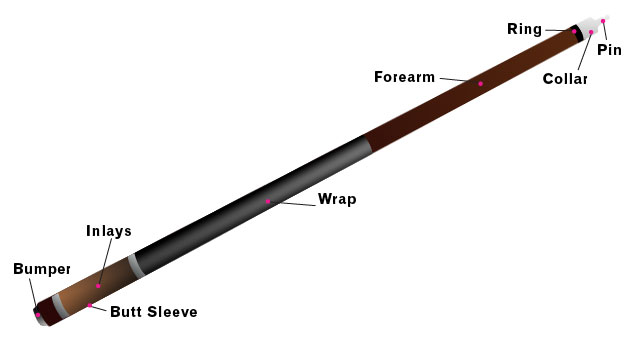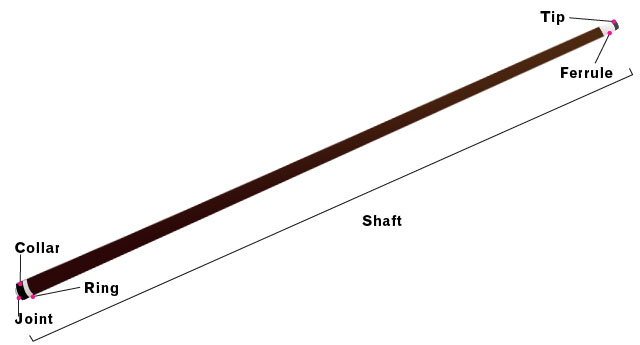Pool Cue Anatomy
Posted on August 7, 2014 at 12:06 pm
Ok, we all know what a pool cue is, but if we were to ask you to point out the “ferrule” would you have the answer?
If not, don’t worry, just refer yourself to our Pool Cue Anatomy blog post and you’ll never be caught short when it comes to getting pool cue terminology correct next time somebody puts you on the spot!

Tip
• Starting from the top, we have the Tip, made from compressed, treated leather.
• Tips measure anything from 11mm to 14mm wide and can be glued or screwed on.
• Tip density can range from soft, medium and hard. Softer tips are generally preferred by beginners, medium the most commonly used and hard tips tend to be for professional use as they allow the experienced player to have more control over their shots.
Ferrule
• Used to strengthen the Cue Tip and to take the impact away from the Shaft, protecting from splintering or breaking.
• Commonly made from solid plastic, this piece can be screwed, glue or slipped on the Cue Shaft.
Shaft
• Normally constructed from Maple, but sometimes manufactured using Graphite or Fibreglass.
• It is important that Shaft is smooth and tapered correctly to ensure that the player can execute an even and smooth stroke when playing shots.
Ring
• The Ring is used to reinforce the Joint of the cue and as a decorative feature. The design of the ring is often repeated on the Butt too.
Collar
• Situated between the back of the Shaft, the Collar enables a consistent and smooth transfer of impact energy to be transferred from the Butt to the Shaft.
• Normally made from Stainless Steel, Wood or Molded Phenolic Resin, the Collar is usually screwed or glued on.
Joint
• Serving a similar purpose to the Collar in terms of allowing a consistent flow of energy to take place, the Joint is also normally constructed from the same set of materials as the Collar too.
• It is important that where the Joints meet at either end of the Shaft and Butt that there are no gaps. The fit should be flush and smooth.
Features of the Cue Butt

Pin
• Normally located at the top of the Butt (although some cues have the Pin at the end of the Shaft) the Pin connects the Shaft to the Butt of the Cue.
Ring
• Serving the same as that on the Shaft, the design of the Ring on the Butt of the Cue will of reflect that of the Shaft.
Collar
• Serving a similar purpose as the Collar located on the Shaft, the Butt Collar also gives the appearance of the Cue being constructed as a single piece.
• Commonly constructed from Stainless Steel.
Forearm
• This may come as a surprise but, this relatively small area of the Cue will often be a big factor in determining it’s price!
• The Forearm is the area that allows manufacturers to add their unique designs to the Cue and to give their own stamp of individuality.
Wrap
• Protecting this area of the Cue from sweaty palms and tight grips, the Wrap helps to ensure the longevity of the Cue.
• The Wrap is normally made from Irish Linen or Leather.
Inlays
• Another area of the Cue that can have a big effect on it’s price, most notably on high end Cues.
• Inlays can often feature intricate designs and use a range of expensive materials to give a Cue a further distinct style and appearance.
Butt Sleeve
• Often reflecting the same design as the Forearm, this part of the Cue is located just below the Wrap.
Bumper
• If you’ve ever played a game in a room that is too small, then you will be familiar with this part of the Cue!
• The rubber Bumper at the end of the Butt is used to absorb impact and protect the Cue in light of any unwanted collisions with walls or passers by!
